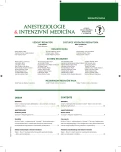Malignant hyperthermia
Authors:
T. Vymazal
Authors‘ workplace:
Klinika anesteziologie, resuscitace a intenzivní medicíny, 2. LF UK a FN v Motole, Praha
Published in:
Anest. intenziv. Med., 27, 2016, č. 2, s. 71-74
Category:
Anesthesiology - Review Article
Overview
Malignant hyperthermia is a rare, life-threatening condition, usually triggered by exposure to certain drugs used for general anaesthesia – specifically volatile anaesthetics (halothane, isoflurane, sevoflurane) and neuromuscular blocking agents (esp. suxamethonium). In susceptible individuals, these drugs can induce a drastic and uncontrolled increase in oxidative metabolism in the skeletal muscle leading to muscle rigidity, which overwhelms the body’s capacity to supply oxygen, remove carbon dioxide and regulate body temperature, eventually leading to circulatory collapse and death if not immediately treated. This review article brings information about the pathophysiology, symptoms, treatment and prevention of malignant hyperthermia for a wide range of clinicians.
Keywords:
malignant hyperthermia – general anaesthesia
Sources
1. Harrison’s Principles of Internal Medicine. 2008, p. 18, 419–20.
2. Civetta, Taylor & Kirby’s Critical Care. 2009, p. 1100–1101, 1331–1334.
3. David E: Longnecker. Anestesiology. 2008. p. 1964–1984.
4. Johannsen, S., Treves, S., Müller, C. R., Mögele, S., Schneiderbanger, D., Roewer, N., Schuster, F. Functional characterization of the RYR1 mutation p.Arg4737Trp associated with susceptibility to malignant hyperthermia. Neuromuscul. Disord., 2015, Nov 11. pii: S0960-8966(15)00770-1. doi: 10.1016/j.nmd.2015.11.001. [Epub ahead of print].
5. Miyamoto, Y., Miyashita, T., Takaki, S,, Goto, T. Perioperative considerations in adult mitochondrial disease: A case series and a review of 111 cases. Mitochondrion., 2015, Nov 19, 26, p. 26–32.
6. Campion, G. H., Hadi, A. S., Berman, A. J., Hoffman, R. S. Questions regarding the diagnosis of malignant hyperthermia. Anesthesiology, 2015, 123, 3, p. 731–732. doi: 10.1097/ALN.0000000000000760.
7. Petersen, B., Busch, T., Meinecke, C. D., Börge, B., Kluba, K., Kaisers, U. X., Rüffert, H. Telephone enquiries on the topic of malignant hyperthermia : Evaluation of the content and subsequent diagnostic results at the MH Center Leipzig. Anaesthesist, 2015, Oct 19. [Epub ahead of print].
8. Isaak, R. S., Stiegler, M. P. Review of crisis resource management (CRM) principles in the setting of intraoperative malignant hyperthermia. J. Anesth., 2015, Dec 17. [Epub ahead of print].
9. Lu, Z., Rosenberg, H., Brady, J. E., Li, G. Prevalence of Malignant Hyperthermia Diagnosis in New York State Ambulatory Surgery Center Discharge Records 2002 to 2011. Anesth. Analg. 2015, Nov 9. [Epub ahead of print].
10. http://www.mhaus.org/
11. http://www.hypertermie.estranky.cz/
12. http://www.mhinfo.cz/info/
Labels
Anaesthesiology, Resuscitation and Inten Intensive Care MedicineArticle was published in
Anaesthesiology and Intensive Care Medicine

2016 Issue 2
Most read in this issue
- Malignant hyperthermia
- Current opinion on caudal epidural blockade and its complications in children
- Intravenous fluid therapy in intensive care
- Sleep disturbances in perioperative and ICU patients – review
